
A roadmap is a visual description which shows a plan against time for achieving one or more goals or objectives. It is used to plan large activities which deliver value to the enterprise. The roadmap can be used to synchronize deliverables with important events and uncover important dependencies between deliverables.


Roadmaps are primarily used in the Innovation and Transformation stages in the engagement model. Under the innovation stage the roadmap can be used to plan and assess feasibility of new initiatives and plan against existing initiatives. Under the transformation the roadmap can be used to track and update the progress of deliverables in work. The Utilization and Measurement stages provide experience and feedback which may alter the future planning on the roadmap.
Roadmaps are used broadly in business for many purposes but this article focuses on strategic roadmaps and product development roadmaps.
Why we need roadmaps
Assignment on the engagement model provides a way of identifying, assigning and prioritizing business initiatives. The roadmap provides a way to plan these initiatives over time.
Roadmaps are important as they provide a common understanding for stakeholders regarding the current status of a business initiative and also a broad plan for future deliverables, goals and objectives. Having a common understanding means that stakeholders will not only be pulling together in the right direction using the business vision and strategy, but also coordinating the timing and dependencies of deliverables.
Visualizing the dependencies between the deliverablessignificantly reduces the risk for deliverables being blocked by other deliverables , and supports the ability of stakeholders to prioritize deliverables.
The roadmap also gives a framework for making broad estimations regarding budget and resources, this can be used to assess the feasibility of a business initiative before detailed planning starts. This avoids spending valuable resources on detail planning of initiatives which lack business feasibility.
Being able to monitor progress and show that an initiative is moving forward is a highly motivating factor for stakeholders. The roadmap provides a tool which shows on a long-term scale how much progress has been made as deliverables are completed, as well as providing a view of the next deliverables to be addressed.
Roadmaps are important for the architect as they provide direction for the architecture against time. This allows the architect to balance architectural decisions against which can be achieved in the given time period. Roadmaps are also a tool for the architect to communicate the consequences of alternative architecture decisions. For example, delivering on a shorter time period may result in a compromise on quality or features, but may be required for other business initiatives. Alternatively extending the time period will allow for better quality or features but results in the delay of other business initiatives.
Roadmap Approach
The following are some key principles which can help in developing good roadmaps.
Make the scope of the roadmap clear
It is important for those who are developing the roadmap to have a common understanding of the roadmap scope. This provides the boundaries for the changes to the enterprise that the roadmap will address. The scope provides an understanding for what is included in the roadmap but importantly also provides the basis for what should not be included. Having a clearly defined scope provides focus for all stakeholders and reduces the risks for misunderstanding.
Business centric planning
The roadmap is defined by the business with the customer or market in focus and is a plan for how to achieve something of value to the business. In the value model the Goals and the Business Case provide the drivers for goals and the objectives on the roadmap. The operating model provides Assignment for the initiatives that are prioritized for work and the the roadmap provides the time plan for when initiatives can be achieved.
Items on a roadmap should clearly contribute to partly or completely meeting a goal or objective which provides value for the enterprise. If the item is not related to a roadmap goal or objective then the item may be out of the roadmap scope. On the roadmap it may be that many items contribute to the same goal or objective, and that one item can contribute to many goals and objectives.
A Roadmap is long term
A roadmap is used as a basis for long term planning. This gives stakeholders a view of what is coming down the line and usually details significantly large changes. For long term planning a broad timeline is used which shows years, quarters and months, where months are the lowest unit of time.
A Roadmap is not a project plan
A roadmap is used for planning large units of change which are driven against goals and objects. When planning a roadmap importance is placed on what is to be done, and not how it is to be done. The roadmap does not consider detailed activities or resources. The roadmap details the plan for what needs to be done and project plans (or other detailed plans) may be used to assess if items on the roadmap are feasible. However, if the roadmap is not feasible then actions need to be taken to change the roadmap, or the change how deliverables on the roadmap are planned (for example, increase resources, increase productivity, consider quality levels).
Working with Roadmaps
Roadmaps are adaptable and can be applied to different scenarios and visualized in different formats. However roadmaps should at least have the following common attributes.
Scope and Vision
The roadmap makes clear the scope that is being address, for example, a business area, a specific business initiative or perhaps a product. The scope may include the vision and time period for the roadmap.The scope also determines timescale of the roadmap. A roadmap is a long-term plan and the timescale of the roadmap determines the level of detail in the planning. Roadmaps are commonly scaled to years, quarters or months.
Goals and objectives
Each deliverable on the roadmap should have a clear goal or objective which will be met once the deliverable is completed.
Deliverables
Deliverables are the items on the roadmap which have a start date and an end date. A deliverable indicates something that will be achieved which contributes to a stated goal or objective, for example a release of a software product, a skills enhancement package or a combination of a series of deliverable packaged in a transition.
Overview of Strategic and Product Roadmaps
In the following sections a description is given of how to work in practice with Strategic Roadmaps and Product Development Roadmaps. In order to place these in context it is important to understand the relationship between these two types of roadmap.
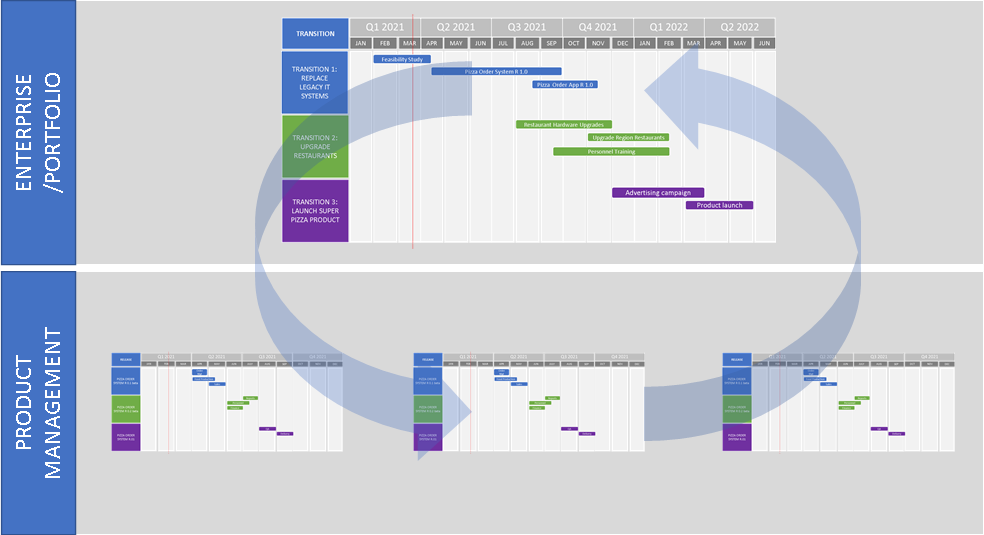
Strategic roadmaps are concerned with planning change in enterprises or large portfolios of products and have a broad scope. These roadmaps are aim at an audience of senior business persons in the organization. Within the strategic roadmap there are a number of deliverables which are linked to product development. This provides the link between the strategic roadmap and each of the product development roadmaps within an organization. This provides a cycle of information where changes in the strategic roadmap affect the product roadmaps and a change in a product roadmap may affect the strategic roadmap. By effectively managing the strategic and product development roadmaps risks, consequences and dependencies can discovered at an early stage and managed to reduce negative effects.
Strategic Roadmaps
When working with strategic roadmaps we often require planning of a series of large deliverables in order to meet a strategic objective or goal. Examples of such deliverables can be changes to the enterprise, business or infrastructure architectures. The strategic roadmap is driven by the Strategy and Assignment in the engagement model, these provide the basis for creating transitions
In order to organize strategic roadmaps, we can refer to a change as a Transition.
“A change from one form to another, or the process by which this happens”
Transition, Cambridge Dictionary
A single Transition states clearly the goal or objective to be satisfied as well as a broad description of the required change. The Transition should itself contain a number of deliverables which are required in order to perform the transition from the initial state to the desired state. The initial state of the Transition may be expressed by a baseline architecture while the desired state may be expressed by a target architecture. Where there are a number of Transitions planned to meet a target architecture, transition architectures may be described for each Transition.
This diagram below uses a fictional pizza company as an example where the roadmap shows the transitions required to launch a new Super Pizza product.
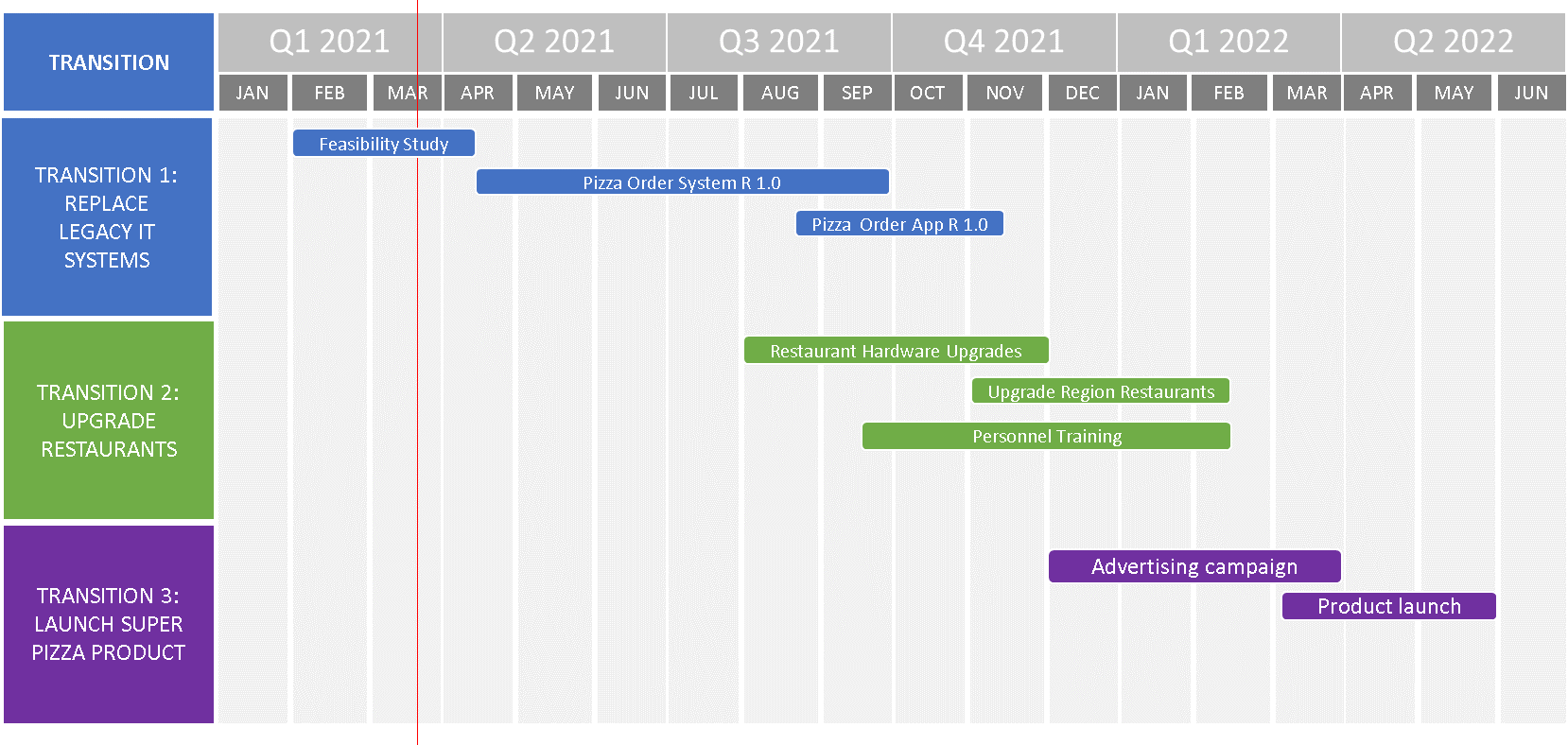
Deliverables which are part of the Transition can take different forms depending on the kind of change enterprise is going through. The following are some examples of deliverables which are commonly found in a Transition:
- business capability
- organization
- skills and competency development
- product releases
- IT infrastructure
Working with a Strategic Roadmap
Planning a strategic roadmap starts with the stakeholders who are responsible for the vision and scope of the initiative. These stakeholders may form a steering committee for the initiative, and call in other key stakeholders to support the creation of the roadmap.
Creating the initial roadmap is challenging as the vision and scope need to be collectively agreed upon by the stakeholders. The goals and objectives need to be defined and the transitions detailed. There may be a large number of stakeholders with opinions regarding the strategy and direction, and while there are many ways in which to construct a roadmap, the following method may provide support.
Step 1: Strategic workshop
A workshop is held for the key stakeholders who have broad knowledge of the business which is affected by the change to the enterprise. The workshop can be held for a maximum of a single day with 4-9 stakeholders. Larger groups of stakeholders will mean more effort in communication and reaching decisions, this reduces the likelihood of the workshop succeeding. A recommendation is to set a timeline of no more than 3 years for the roadmap.
The following Strategic Roadmap Canvas can be used to support the workshop. A simple method which can be used is to pin the canvas to the wall and throughout the workshop stakeholders can use sticky notes to add information to the canvas.
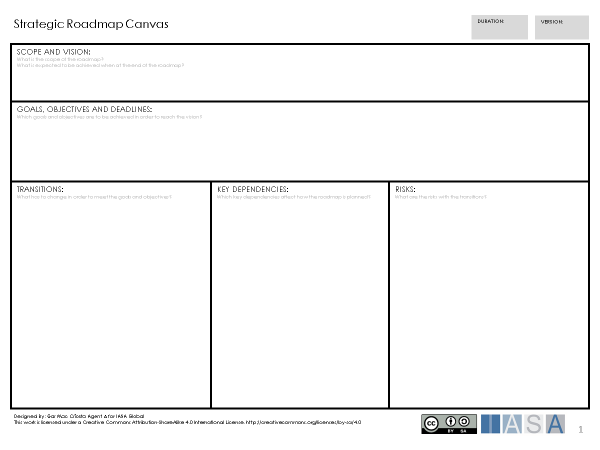
The following describes a process which may be used to formulate the transitions in a roadmap.
- Formulate the Scope and Vision
The stakeholders who are responsible for the initiative should describe the scope and vision. Other stakeholders at the workshop have the opportunity to comment and suggest changes. The scope and vision are formulated in a way which all stakeholders agree on. - Define the Goals, Objectives and Deadlines
The stakeholders define important goals and objectives which shall be met by the initiative. These goals and objectives shall adhere to the scope and vision and are given expected delivery dates or deadlines. - Define the transitions
The stakeholders start to define the major changes which are needed to transform the business to a state which will meet the vision. Each transition should contribute partly or completely to the achievement of the define goals and objectives. As the transitions are defined stakeholders can also note key dependencies for the transitions and any risks that are identified.
The result of the workshop is information structured on the canvas which can be used to create a broad roadmap plotting the transitions required to achieve the goals and the objectives.
Step 2: Transitions Workshops
Using the transitions from the Strategic Roadmap Canvas, key stakeholders are called to a series of transition workshops where each workshop focuses on a single transition. Similar to the Strategic Workshop, the recommended number of stakeholders is 4-9 persons. The transition workshop is held for a period of 2-4 hours depending on the complexity of the transition.
The following canvas can support the workshop by placing the canvas on a wall where the stakeholders can visualize the details of the transition. A recommendation is to use sticky notes method.
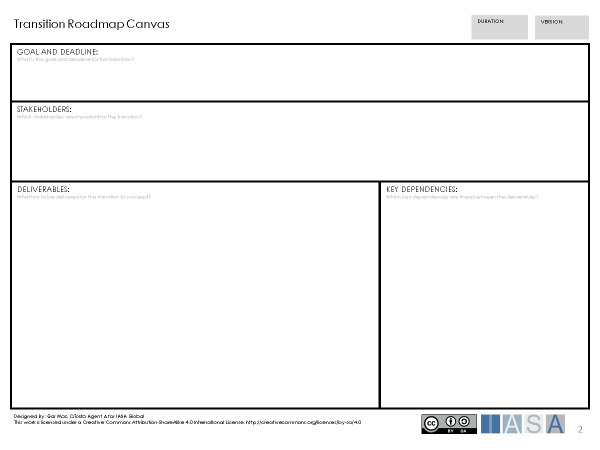
The following describes a process which may be used to formulate the details of a transition in a roadmap.
- Using the results from the Strategic Roadmap Workshop state the goal and deadline of the transition, and then refine this as required to gain agreement from the key stakeholders.
- Define the stakeholders in the enterprise who are likely to be affected by the transition. This will aid communication of the roadmap and identify stakeholders who may actively affect the roadmap.
- Consider the details of the transition and changes which will occur in the transition. Express these in terms of deliverables. Some examples of deliverables are, changes to the business process, training, software release or infrastructure upgrades. Each deliverable should be detailed with a start and delivery date.
- Consider the dependencies between deliverables which will affect how the roadmap is planned.
During the workshop the different areas of the canvas may be revisited, for example new stakeholders may be uncovered when considering deliverables, or new deliverables may be uncovered when considering key dependencies.
The result of the workshop is detailed deliverables which can be added to the roadmap using key dependencies to prioritize the deliverables. The detailing of stakeholders also helps to form an organization for communication of the roadmap and reporting channels for information.
Product Development Roadmaps
Product development roadmaps are used for long term planning of a single specific product. Product development roadmaps are focused on releases, features and events. A release is a version of the product which contains a set of features that can be delivered to stakeholders. Each release has a clear scope, stakeholders, goals and objectives. If the release is part of a Transition these may already be defined in the Transition Roadmap Canvas.
“A product release is the process of launching a new product for a specific market or user base. In software development, a product release is sometimes done with a beta version so that core developers/users can assist with debugging and feedback prior to the release of the actual software.”
Definition of Product Release, www.techopedia.com
The product development roadmap provides a common plan and direction for product management and the development teams. Major releases may appear as deliverables on a strategic roadmap, this provides alignment with stakeholders working with the enterprise strategy.
“A function of an item which is capable of gratifying a particular consumer need and is hence seen as a benefit of owning the item.”
Definition of Feature, www.businessdictionary.com
Each release on the roadmap contains a set of features. Features in the roadmap are deliverables within a release and provide a way for product management and the development team to organize and prioritize the content of a release. A feature is a substantially large function which partly or completely fulfils a requirement on the product. In agile methods a feature is often defined as an Epic. Releases may also contain major events in the development cycle such as final QA (quality assurance) or delivery.
The diagram below illustrates a fictional roadmap for the Pizza Order System previously described in the example strategic roadmap. It shows the features and events related to each release.
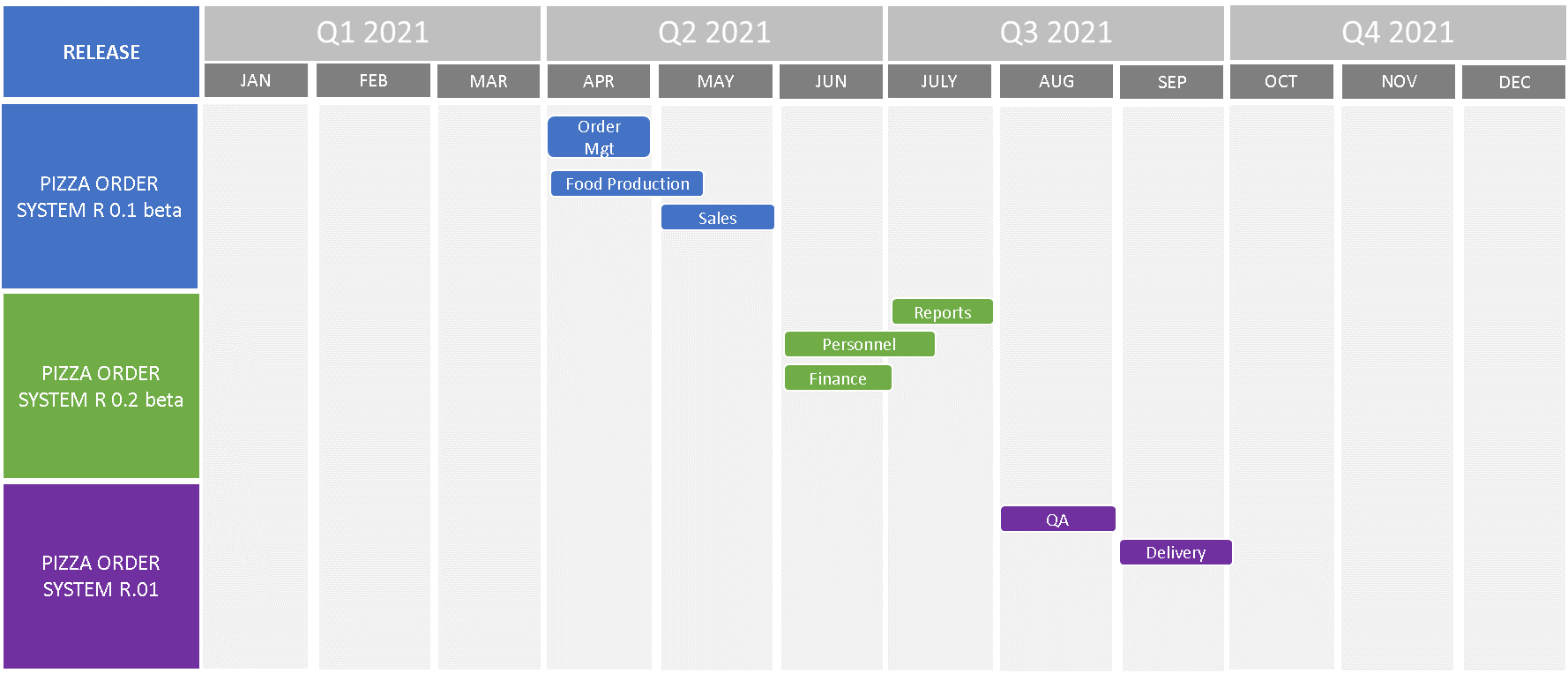
The product development roadmap provides the basis for detailed planning. This gives a framework for product management and the development teams to plan activities, resources and budgets in detailed plans.
Working with a Product Roadmap
The planning of a Product Roadmap begins with the Product Management stakeholders. Product Management stakeholders provide the link between the deliverable in the Strategic Roadmap and the more detailed planning which gives the Development Team scope and direction.
When starting a new product development or in the event of major product changes the following method may support the creation of a Product Roadmap.
Step 1: Product Planning Workshop
In order to plan the roadmap, the Product Management stakeholders call key stakeholders to a workshop. The workshop may be held for 2-4 hours and the number of stakeholders should be between 4-9 persons. As a recommendation, set a timeline of no more than 2 years for the roadmap.
As an input to the workshop a number of product releases may already be defined in the Strategic Roadmap as deliverables to transitions. However, it is also reasonable to expect that releases may be planned which are not connected to a transition.
The following Product Roadmap Canvas can be used to support the workshop. The canvas can be pinned to the wall and sticky notes used to visualize information on the canvas.
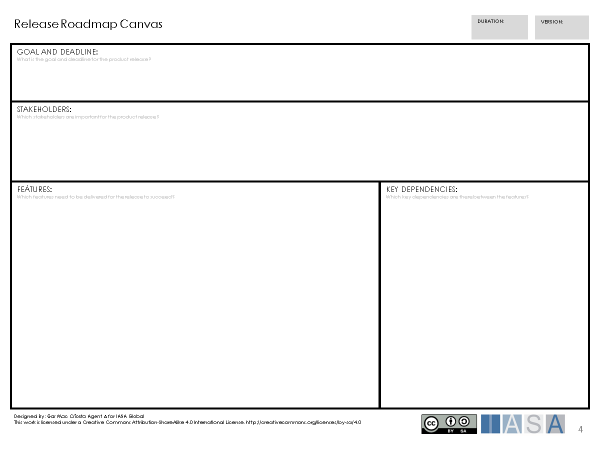
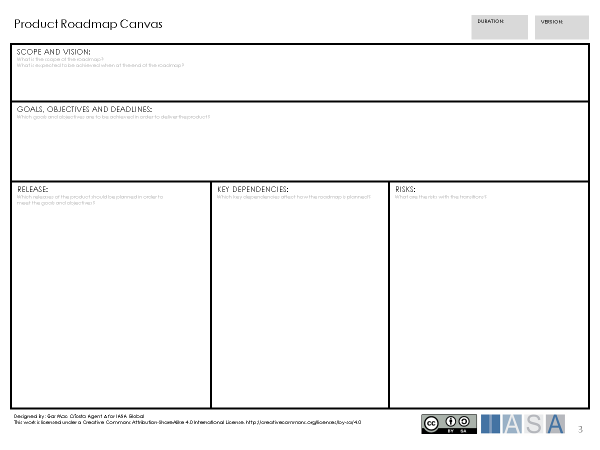
The following describes a process which may be used to formulate the product roadmap.
- The Product Management stakeholders describe the scope and vision for the product. This sets the context for content and features. This is important to ensure that only relevant features are placed in the product. Scope and vision for the product is refined until key stakeholders are in agreement.
- Product Management and key stakeholders then define the goals and objectives for the product, observing the scope and vision. The goals and objectives for the product may be associated with goals and objectives in the Strategic Roadmap. Deadlines should be given for each goal or objective.
- Releases are then planned from the goals and the objectives on the product. A broad description of the content of the release is given. As the releases are discussed key dependencies between releases may be identified as well as risks.
The result of this workshop acts as input for creating releases on the roadmap. Each release can be planned to a deadline and have a clear goal or objective. Key dependencies aid the prioritization of releases on the timeline, while mitigation can start on identified risks.
Step 2: Release Planning Workshop
After the Product Planning Workshop, a roadmap now shows the planned releases for the product, with goals, objectives and deadlines. The next challenge for Product Management stakeholders is to plan the development of features in a release.
This involves Project Management stakeholders and the Development Teams. How this planning takes place depends very much on the product development method. Some products run release cycles of from 6 months to 1 year, others have a release cycle of 6 weeks, some releases run in parallel. This affects the way the product releases are planned and how Release Planning workshops will be used.
The aim of the Release Planning Workshop is to involve the Project Management stakeholders and the Development Teams in planning the features for a single release.
The following Release Roadmap Canvas can be used to support the workshop. As with the other workshops the canvas can be pinned to the wall and sticky notes used to visualize information on the canvas.

The following process may be used to formulate a release.
- The Product Management stakeholders state the goal and deadline for the release.
- The Product Management stakeholders and Development Team identify stakeholders that have a vested interest in the value the release provides. These are stakeholders who will benefit from the release.
- The Product Management stakeholders and Development Team define the features of the release. These may be based on an existing requirements specification, or they may be an initiative of the team. Features are aligned with the goal of the release and provide a stated value and should have a deadline.
- Key dependencies between features are identified by the team.
The result of the workshop is a series of features which can be plotted on the Product Development Roadmap according to deadlines and with respect to key dependencies.
References and further reading
UK Government
https://www.gov.uk/service-manual/agile-delivery/developing-a-roadmap
TOGAF ( section 32.2.7)
https://pubs.opengroup.org/architecture/togaf9-doc/arch/chap32.html#tag_32_02_07
Roman Pichler
https://www.romanpichler.com/blog/category/product-roadmap/

BTABoK 3.0 by IASA is licensed under a Creative Commons Attribution-NonCommercial 4.0 International License. Based on a work at https://btabok.iasaglobal.org/







